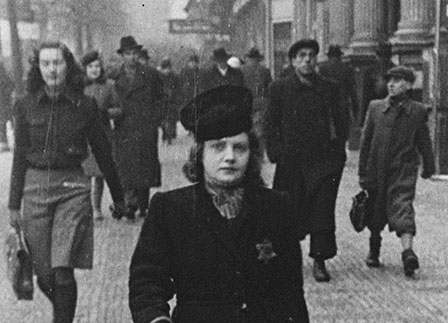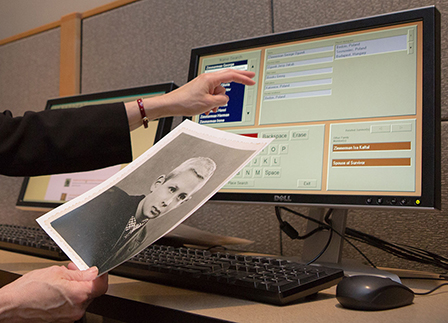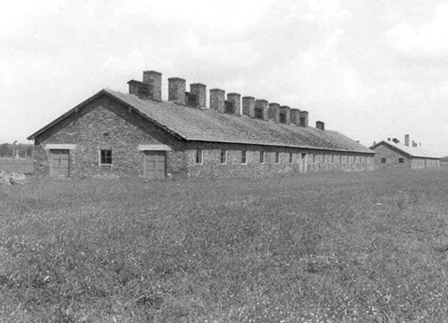Overview
- Brief Narrative
- Shoemaker's fudge wheel (also called a welt wheel), similar to those used by Jewish forced laborers in the Łódź Ghetto in German-occupied Poland from May 1940 to summer 1944. Fudge wheels were heated and run around the top edge of shoe soles (the welt), creating ridged impressions. Depending on the goal of the shoemaker, it could mark leather for even hand-stitching, give the appearance of being hand-stitched, or tighten or flatten the stitches on the welt. Łódź was occupied by Germany a week after the September 1939 invasion of Poland. It was renamed Litzmannstadt, and in February 1940, the Jewish population of about 160,000 people was confined to a small, sealed-off ghetto. All residents had to work, and 85 percent of the ghetto population labored in nearly 100 factories. The major ones produced textiles, including uniforms for the German Army. Occupying authorities seized much of the specialized machinery from the Jewish population, forcing them to use hand techniques for production. Due to severe overcrowding and scarce food, disease and starvation were common. The Judenrat (Jewish Council) administered the ghetto for the Germans, and chairman Mordechai Rumkowski thought hard work and high output would preserve the ghetto. However, in January 1942, mass deportations to Chelmno killing center began; half the residents were murdered by the end of the year. In summer 1944, Łódź, the last ghetto in Poland, was destroyed and the remaining Jews were sent to Chelmno and Auschwitz-Birkenau killing centers.
- Date
-
use:
approximately 1900-approximately 1945
- Geography
-
acquired:
Poland
- Credit Line
- United States Holocaust Memorial Museum Collection
Physical Details
- Classification
-
Tools and Equipment
- Category
-
Shoemaking equipment and supplies
- Object Type
-
Tools (lcsh)
- Genre/Form
- Hand tools.
- Physical Description
- Small shoemaker's fudge wheel (also known as a welt wheel) with a turned wooden handle. The tool consists of a rectangular metal bar approximately 2 inches in length, with a circular, toothed metal wheel on the tip. The wheel is attached to the bar with a small metal knob, and at the bottom of the bar is a tapered metal collar that fits onto the narrow end of the handle. The handle flares out, then curves inward before ballooning to a round end. An incised line encircles the handle near the bottom, and a black leather hanging tab with a small slit is attached to the end.
- Dimensions
- overall: Height: 6.000 inches (15.24 cm) | Width: 1.000 inches (2.54 cm) | Depth: 1.000 inches (2.54 cm)
- Materials
- overall : wood, leather, metal
Rights & Restrictions
- Conditions on Access
- No restrictions on access
- Conditions on Use
- No restrictions on use
Keywords & Subjects
Administrative Notes
- Legal Status
- Permanent Collection
- Provenance
- The wheel was acquired by the United States Holocaust Memorial Museum in 1990.
- Record last modified:
- 2023-06-14 07:08:01
- This page:
- https://collections.ushmm.org/search/catalog/irn3422
Download & Licensing
In-Person Research
- By Appointment
- Request 21 Days in Advance of Visit
- Plan a Research Visit
- Request to See This Object
Contact Us
Also in Łódź ghetto hand tools collection
The collection consists of a variety of shoe and garment-making tools of the type used in Łódź Ghetto during the Holocaust.
Date: approximately 1900-approximately 1930
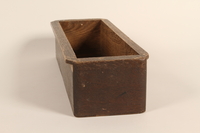
Pfaff treadle sewing machine table of the type used in Łódź Ghetto
Object
Pfaff treadle sewing machine tables like this were used by Jewish forced laborers in Łódź Ghetto in German occupied Poland from May 1940 to summer 1944. This mass produced machine was very durable and affordable. Łódź was occupied by Germany a week after the September 1939 invasion of Poland. It was renamed Litzmannstadt and, in February 1940, the Jewish population, about 160,000 people, was confined to a small sealed off ghetto. All residents had to work and many were forced laborers in ghetto factories. Eventually, nearly 100 factories were in operation. The major ones produced textiles, including uniforms for the German Army. Due to the severe overcrowding and scarce food, disease and starvation were common. The Judenrat [Jewish Council] administered the ghetto for the Germans. Judenrat chairman Mordechai Rumkowski thought hard work and high outputs would preserve the ghetto. But in January 1942, mass deportations to Chelmno killing center began; half the residents were murdered by the end of the year. In summer 1944, Łódź, the last ghetto in Poland, was destroyed and the remaining Jews were sent to Chelmno and Auschwitz-Birkenau killing centers.
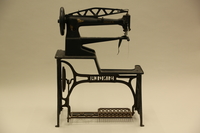
Singer treadle sewing machine of the type used by a cobbler in Łódź Ghetto
Object
Cobbler's style treadle sewing machine and tables like this Singer style model were used by Jewish forced laborers in Łódź Ghetto in German occupied Poland from May 1940 to summer 1944. This mass produced machine was very durable and affordable. Łódź was occupied by Germany a week after the September 1939 invasion of Poland. It was renamed Litzmannstadt and, in February 1940, the Jewish population, about 160,000 people, was confined to a small sealed off ghetto. All residents had to work and many were forced laborers in ghetto factories. Eventually, nearly 100 factories were in operation. The major ones produced textiles, including uniforms for the German Army. Due to the severe overcrowding and scarce food, disease and starvation were common. The Judenrat [Jewish Council] administered the ghetto for the Germans. Judenrat chairman Mordechai Rumkowski thought hard work and high outputs would preserve the ghetto. But in January 1942, mass deportations to Chelmno killing center began; half the residents were murdered by the end of the year. In summer 1944, Łódź, the last ghetto in Poland, was destroyed and the remaining Jews were sent to Chelmno and Auschwitz-Birkenau killing centers.
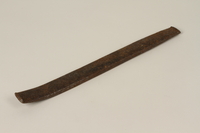
Flat file of the type used in Łódź Ghetto
Object
Flat file, possibly for a shoemaker, similar to those used by Jewish forced laborers in the Łódź Ghetto in German-occupied Poland from May 1940 to summer 1944. Łódź was occupied by Germany a week after the September 1939 invasion of Poland. It was renamed Litzmannstadt and in February 1940, the Jewish population of about 160,000 people was confined to a small, sealed-off ghetto. All residents had to work, and 85 percent of the ghetto population labored in nearly 100 factories. The major ones produced textiles, including uniforms for the German Army. Occupying authorities seized much of the specialized machinery from the Jewish population, forcing them to use hand techniques for production. Due to severe overcrowding and scarce food, disease and starvation were common. The Judenrat (Jewish Council) administered the ghetto for the Germans, and chairman Mordechai Rumkowski thought hard work and high output would preserve the ghetto. However, in January 1942, mass deportations to Chelmno killing center began; half the residents were murdered by the end of the year. In summer 1944, Łódź, the last ghetto in Poland, was destroyed and the remaining Jews were sent to Chelmno and Auschwitz-Birkenau killing centers.
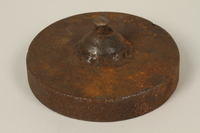
Metal scale weight of the type used in Łódź Ghetto
Object
Scale weight, possibly for a shoemaker, similar to those used by Jewish forced laborers in the Łódź Ghetto in German-occupied Poland from May 1940 to summer 1944. Łódź was occupied by Germany a week after the September 1939 invasion of Poland. It was renamed Litzmannstadt and in February 1940, the Jewish population of about 160,000 people was confined to a small, sealed-off ghetto. All residents had to work, and 85 percent of the ghetto population labored in nearly 100 factories. The major ones produced textiles, including uniforms for the German Army. Occupying authorities seized much of the specialized machinery from the Jewish population, forcing them to use hand techniques for production. Due to severe overcrowding and scarce food, disease and starvation were common. The Judenrat (Jewish Council) administered the ghetto for the Germans, and chairman Mordechai Rumkowski thought hard work and high output would preserve the ghetto. However, in January 1942, mass deportations to Chelmno killing center began; half the residents were murdered by the end of the year. In summer 1944, Łódź, the last ghetto in Poland, was destroyed and the remaining Jews were sent to Chelmno and Auschwitz-Birkenau killing centers.
Sleeve ironing board of the type used in Łódź Ghetto
Object
Sleeve ironing board or pressing ham, of the type used by Jewish forced laborers in the Łódź Ghetto in German-occupied Poland from May 1940 to summer 1944. Sleeve ironing boards and pressing hams were used for shirtsleeves and curved seams to prevent the creation of sharp creases. Łódź was occupied by Germany a week after the September 1939 invasion of Poland. It was renamed Litzmannstadt, and in February 1940, the Jewish population of about 160,000 people was confined to a small, sealed-off ghetto. All residents had to work, and 85 percent of the ghetto population labored in nearly 100 factories. The major ones produced textiles, including uniforms for the German Army. Occupying authorities seized much of the specialized machinery from the Jewish population, forcing them to use hand techniques for production. Due to severe overcrowding and scarce food, disease and starvation were common. The Judenrat (Jewish Council) administered the ghetto for the Germans, and chairman Mordechai Rumkowski thought hard work and high output would preserve the ghetto. However, in January 1942, mass deportations to Chelmno killing center began; half the residents were murdered by the end of the year. In summer 1944, Łódź, the last ghetto in Poland, was destroyed and the remaining Jews were sent to Chelmno and Auschwitz-Birkenau killing centers.
Box iron of the type used in Łódź Ghetto
Object
Box iron, similar to those used by Jewish forced laborers in the Łódź Ghetto in German-occupied Poland from May 1940 to summer 1944. The iron would have been heated by inserting a hot piece of metal, called a slug, into the hollow cavity of the iron. Generally, two slugs were alternated, so that one was always being heated while the other was in use. Unlike the flat, or sad iron, the surface of the box iron could be kept away from the fire, ensuring that the garment was not soiled by soot or dirt. Łódź was occupied by Germany a week after the September 1939 invasion of Poland. It was renamed Litzmannstadt, and in February 1940, the Jewish population of about 160,000 people was confined to a small, sealed-off ghetto. All residents had to work, and 85 percent of the ghetto population labored in nearly 100 factories. The major ones produced textiles, including uniforms for the German Army. Occupying authorities seized much of the specialized machinery from the Jewish population, forcing them to use hand techniques for production. Due to severe overcrowding and scarce food, disease and starvation were common. The Judenrat (Jewish Council) administered the ghetto for the Germans, and chairman Mordechai Rumkowski thought hard work and high output would preserve the ghetto. However, in January 1942, mass deportations to Chelmno killing center began; half the residents were murdered by the end of the year. In summer 1944, Łódź, the last ghetto in Poland, was destroyed and the remaining Jews were sent to Chelmno and Auschwitz-Birkenau killing centers.
Shoemaker’s stool of the type used in Łódź Ghetto
Object
Handmade stool, possibly for a shoemaker, similar to those used by Jewish forced laborers in the Łódź Ghetto in German-occupied Poland from May 1940 to summer 1944. Łódź was occupied by Germany a week after the September 1939 invasion of Poland. It was renamed Litzmannstadt, and in February 1940, the Jewish population of about 160,000 people was confined to a small, sealed-off ghetto. All residents had to work, and 85 percent of the ghetto population labored in nearly 100 factories. The major ones produced textiles, including uniforms for the German Army. Occupying authorities seized much of the specialized machinery from the Jewish population, forcing them to use hand techniques for production. Due to severe overcrowding and scarce food, disease and starvation were common. The Judenrat (Jewish Council) administered the ghetto for the Germans, and chairman Mordechai Rumkowski thought hard work and high output would preserve the ghetto. However, in January 1942, mass deportations to Chelmno killing center began; half the residents were murdered by the end of the year. In summer 1944, Łódź, the last ghetto in Poland, was destroyed and the remaining Jews were sent to Chelmno and Auschwitz-Birkenau killing centers.
Shoemaker's knife of the type used in Łódź Ghetto
Object
Shoemaker’s knife, similar to those used by Jewish forced laborers in the Łódź Ghetto in German-occupied Poland from May 1940 to summer 1944. Łódź was occupied by Germany a week after the September 1939 invasion of Poland. It was renamed Litzmannstadt, and in February 1940, the Jewish population of about 160,000 people was confined to a small, sealed-off ghetto. All residents had to work, and 85 percent of the ghetto population labored in nearly 100 factories. The major ones produced textiles, including uniforms for the German Army. Occupying authorities seized much of the specialized machinery from the Jewish population, forcing them to use hand techniques for production. Due to severe overcrowding and scarce food, disease and starvation were common. The Judenrat (Jewish Council) administered the ghetto for the Germans, and chairman Mordechai Rumkowski thought hard work and high output would preserve the ghetto. However, in January 1942, mass deportations to Chelmno killing center began; half the residents were murdered by the end of the year. In summer 1944, Łódź, the last ghetto in Poland, was destroyed and the remaining Jews were sent to Chelmno and Auschwitz-Birkenau killing centers.
Shoemaker's rasp of the type used in Łódź Ghetto
Object
Shoemaker's rasp, similar to those used by Jewish forced laborers in the Łódź Ghetto in German-occupied Poland from May 1940 to summer 1944. Łódź was occupied by Germany a week after the September 1939 invasion of Poland. It was renamed Litzmannstadt, and in February 1940, the Jewish population of about 160,000 people was confined to a small, sealed-off ghetto. All residents had to work, and 85 percent of the ghetto population labored in nearly 100 factories. The major ones produced textiles, including uniforms for the German Army. Occupying authorities seized much of the specialized machinery from the Jewish population, forcing them to use hand techniques for production. Due to severe overcrowding and scarce food, disease and starvation were common. The Judenrat (Jewish Council) administered the ghetto for the Germans, and chairman Mordechai Rumkowski thought hard work and high output would preserve the ghetto. However, in January 1942, mass deportations to Chelmno killing center began; half the residents were murdered by the end of the year. In summer 1944, Łódź, the last ghetto in Poland, was destroyed and the remaining Jews were sent to Chelmno and Auschwitz-Birkenau killing centers.
Shoemaker's screw mount awl handle of the type used in Łódź Ghetto
Object
Awl handle, possibly for a shoemaker, similar to those used by Jewish forced laborers in the Łódź Ghetto in German-occupied Poland from May 1940 to summer 1944. Awls have a sharp metal point that is used to mark or pierce leather, and come in a variety of shapes and sizes. Awls with interchangeable blades allow the leatherworker to save on storage space and customize a tool to their preferences. Łódź was occupied by Germany a week after the September 1939 invasion of Poland. It was renamed Litzmannstadt, and in February 1940, the Jewish population of about 160,000 people was confined to a small, sealed-off ghetto. All residents had to work, and 85 percent of the ghetto population labored in nearly 100 factories. The major ones produced textiles, including uniforms for the German Army. Occupying authorities seized much of the specialized machinery from the Jewish population, forcing them to use hand techniques for production. Due to severe overcrowding and scarce food, disease and starvation were common. The Judenrat (Jewish Council) administered the ghetto for the Germans, and chairman Mordechai Rumkowski thought hard work and high output would preserve the ghetto. However, in January 1942, mass deportations to Chelmno killing center began; half the residents were murdered by the end of the year. In summer 1944, Łódź, the last ghetto in Poland, was destroyed and the remaining Jews were sent to Chelmno and Auschwitz-Birkenau killing centers.
Shoemaker's lasting pliers of the type used in Łódź Ghetto
Object
Lasting pliers, similar to those used by Jewish forced laborers in the Łódź Ghetto in German-occupied Poland from May 1940 to summer 1944. Lasting pliers are used by shoemakers to grip a piece of leather, stretch it over the shoe form (or last), and hold it until the leather can be nailed in place. Łódź was occupied by Germany a week after the September 1939 invasion of Poland. It was renamed Litzmannstadt, and in February 1940, the Jewish population of about 160,000 people was confined to a small, sealed-off ghetto. All residents had to work, and 85 percent of the ghetto population labored in nearly 100 factories. The major ones produced textiles, including uniforms for the German Army. Occupying authorities seized much of the specialized machinery from the Jewish population, forcing them to use hand techniques for production. Due to severe overcrowding and scarce food, disease and starvation were common. The Judenrat (Jewish Council) administered the ghetto for the Germans, and chairman Mordechai Rumkowski thought hard work and high output would preserve the ghetto. However, in January 1942, mass deportations to Chelmno killing center began; half the residents were murdered by the end of the year. In summer 1944, Łódź, the last ghetto in Poland, was destroyed and the remaining Jews were sent to Chelmno and Auschwitz-Birkenau killing centers.
Shoemaker's hammer of the type used in Łódź Ghetto
Object
Hammer, possibly for a shoemaker, similar to those used by Jewish forced laborers in the Łódź Ghetto in German-occupied Poland from May 1940 to summer 1944. Łódź was occupied by Germany a week after the September 1939 invasion of Poland. It was renamed Litzmannstadt, and in February 1940, the Jewish population of about 160,000 people was confined to a small, sealed-off ghetto. All residents had to work, and 85 percent of the ghetto population labored in nearly 100 factories. The major ones produced textiles, including uniforms for the German Army. Occupying authorities seized much of the specialized machinery from the Jewish population, forcing them to use hand techniques for production. Due to severe overcrowding and scarce food, disease and starvation were common. The Judenrat (Jewish Council) administered the ghetto for the Germans, and chairman Mordechai Rumkowski thought hard work and high output would preserve the ghetto. However, in January 1942, mass deportations to Chelmno killing center began; half the residents were murdered by the end of the year. In summer 1944, Łódź, the last ghetto in Poland, was destroyed and the remaining Jews were sent to Chelmno and Auschwitz-Birkenau killing centers.
Shoemaker's round file of the type used in Łódź Ghetto
Object
Round file, possibly for a shoemaker, similar to those used by Jewish forced laborers in the Łódź Ghetto in German-occupied Poland from May 1940 to summer 1944. Łódź was occupied by Germany a week after the September 1939 invasion of Poland. It was renamed Litzmannstadt, and in February 1940, the Jewish population of about 160,000 people was confined to a small, sealed-off ghetto. All residents had to work, and 85 percent of the ghetto population labored in nearly 100 factories. The major ones produced textiles, including uniforms for the German Army. Occupying authorities seized much of the specialized machinery from the Jewish population, forcing them to use hand techniques for production. Due to severe overcrowding and scarce food, disease and starvation were common. The Judenrat (Jewish Council) administered the ghetto for the Germans, and chairman Mordechai Rumkowski thought hard work and high output would preserve the ghetto. However, in January 1942, mass deportations to Chelmno killing center began; half the residents were murdered by the end of the year. In summer 1944, Łódź, the last ghetto in Poland, was destroyed and the remaining Jews were sent to Chelmno and Auschwitz-Birkenau killing centers.
Shoemaker's finishing iron of the type used in Łódź Ghetto
Object
Shoemaker's finishing iron, similar to those used by Jewish forced laborers in the Łódź Ghetto in German-occupied Poland from May 1940 to summer 1944. Finishing irons were heated over a flame, then run around the edge of a shoe sole, creating a smooth and even appearance. The irons were often part of a set, and had different-sized notches on the end, which corresponded to the different thicknesses of shoe soles. Łódź was occupied by Germany a week after the September 1939 invasion of Poland. It was renamed Litzmannstadt, and in February 1940, the Jewish population of about 160,000 people was confined to a small, sealed-off ghetto. All residents had to work, and 85 percent of the ghetto population labored in nearly 100 factories. The major ones produced textiles, including uniforms for the German Army. Occupying authorities seized much of the specialized machinery from the Jewish population, forcing them to use hand techniques for production. Due to severe overcrowding and scarce food, disease and starvation were common. The Judenrat (Jewish Council) administered the ghetto for the Germans, and chairman Mordechai Rumkowski thought hard work and high output would preserve the ghetto. However, in January 1942, mass deportations to Chelmno killing center began; half the residents were murdered by the end of the year. In summer 1944, Łódź, the last ghetto in Poland, was destroyed and the remaining Jews were sent to Chelmno and Auschwitz-Birkenau killing centers.
Shoemaker's finishing iron of the type used in Łódź Ghetto
Object
Shoemaker's finishing iron, similar to those used by Jewish forced laborers in the Łódź Ghetto in German-occupied Poland from May 1940 to summer 1944. Finishing irons were heated over a flame, then run around the edge of a shoe sole, creating a smooth and even appearance. The irons were often part of a set, and had different-sized notches on the end, which corresponded to the different thicknesses of shoe soles. Łódź was occupied by Germany a week after the September 1939 invasion of Poland. It was renamed Litzmannstadt, and in February 1940, the Jewish population of about 160,000 people was confined to a small, sealed-off ghetto. All residents had to work, and 85 percent of the ghetto population labored in nearly 100 factories. The major ones produced textiles, including uniforms for the German Army. Occupying authorities seized much of the specialized machinery from the Jewish population, forcing them to use hand techniques for production. Due to severe overcrowding and scarce food, disease and starvation were common. The Judenrat (Jewish Council) administered the ghetto for the Germans, and chairman Mordechai Rumkowski thought hard work and high output would preserve the ghetto. However, in January 1942, mass deportations to Chelmno killing center began; half the residents were murdered by the end of the year. In summer 1944, Łódź, the last ghetto in Poland, was destroyed and the remaining Jews were sent to Chelmno and Auschwitz-Birkenau killing centers.
Shoemaker's peg breaker of the type used in Łódź Ghetto
Object
Shoemaker's peg breaker, similar to those used by Jewish forced laborers in the Łódź Ghetto in German-occupied Poland from May 1940 to summer 1944. The tool is inserted into the shoe, and moved back and forth to break the wooden pegs used to hold pieces of the shoe together. The rough surface on the head of the tool both catches the pegs and smooths the broken edges. Łódź was occupied by Germany a week after the September 1939 invasion of Poland. It was renamed Litzmannstadt, and in February 1940, the Jewish population of about 160,000 people was confined to a small, sealed-off ghetto. All residents had to work, and 85 percent of the ghetto population labored in nearly 100 factories. The major ones produced textiles, including uniforms for the German Army. Occupying authorities seized much of the specialized machinery from the Jewish population, forcing them to use hand techniques for production. Due to severe overcrowding and scarce food, disease and starvation were common. The Judenrat (Jewish Council) administered the ghetto for the Germans, and chairman Mordechai Rumkowski thought hard work and high output would preserve the ghetto. However, in January 1942, mass deportations to Chelmno killing center began; half the residents were murdered by the end of the year. In summer 1944, Łódź, the last ghetto in Poland, was destroyed and the remaining Jews were sent to Chelmno and Auschwitz-Birkenau killing centers.
Shoemaker's finishing iron of the type used in Łódź Ghetto
Object
Shoemaker's finishing iron, similar to those used by Jewish forced laborers in the Łódź Ghetto in German-occupied Poland from May 1940 to summer 1944. Finishing irons were heated over a flame, then run around the edge of a shoe sole, creating a smooth and even appearance. The irons were often part of a set, and had different-sized notches on the end, which corresponded to the different thicknesses of shoe soles. Łódź was occupied by Germany a week after the September 1939 invasion of Poland. It was renamed Litzmannstadt, and in February 1940, the Jewish population of about 160,000 people was confined to a small, sealed-off ghetto. All residents had to work, and 85 percent of the ghetto population labored in nearly 100 factories. The major ones produced textiles, including uniforms for the German Army. Occupying authorities seized much of the specialized machinery from the Jewish population, forcing them to use hand techniques for production. Due to severe overcrowding and scarce food, disease and starvation were common. The Judenrat (Jewish Council) administered the ghetto for the Germans, and chairman Mordechai Rumkowski thought hard work and high output would preserve the ghetto. However, in January 1942, mass deportations to Chelmno killing center began; half the residents were murdered by the end of the year. In summer 1944, Łódź, the last ghetto in Poland, was destroyed and the remaining Jews were sent to Chelmno and Auschwitz-Birkenau killing centers.
Shoemaker's square file of the type used in Łódź Ghetto
Object
Square file, possibly for a shoemaker, similar to those used by Jewish forced laborers in the Łódź Ghetto in German-occupied Poland from May 1940 to summer 1944. Łódź was occupied by Germany a week after the September 1939 invasion of Poland. It was renamed Litzmannstadt, and in February 1940, the Jewish population of about 160,000 people was confined to a small, sealed-off ghetto. All residents had to work, and 85 percent of the ghetto population labored in nearly 100 factories. The major ones produced textiles, including uniforms for the German Army. Occupying authorities seized much of the specialized machinery from the Jewish population, forcing them to use hand techniques for production. Due to severe overcrowding and scarce food, disease and starvation were common. The Judenrat (Jewish Council) administered the ghetto for the Germans, and chairman Mordechai Rumkowski thought hard work and high output would preserve the ghetto. However, in January 1942, mass deportations to Chelmno killing center began; half the residents were murdered by the end of the year. In summer 1944, Łódź, the last ghetto in Poland, was destroyed and the remaining Jews were sent to Chelmno and Auschwitz-Birkenau killing centers.
Shoemaker's tool of the type used in Łódź Ghetto
Object
Metal tool, possibly for a shoemaker, similar to those used by Jewish forced laborers in the Łódź Ghetto in German-occupied Poland from May 1940 to summer 1944. Łódź was occupied by Germany a week after the September 1939 invasion of Poland. It was renamed Litzmannstadt, and in February 1940, the Jewish population of about 160,000 people was confined to a small, sealed-off ghetto. All residents had to work, and 85 percent of the ghetto population labored in nearly 100 factories. The major ones produced textiles, including uniforms for the German Army. Occupying authorities seized much of the specialized machinery from the Jewish population, forcing them to use hand techniques for production. Due to severe overcrowding and scarce food, disease and starvation were common. The Judenrat (Jewish Council) administered the ghetto for the Germans, and chairman Mordechai Rumkowski thought hard work and high output would preserve the ghetto. However, in January 1942, mass deportations to Chelmno killing center began; half the residents were murdered by the end of the year. In summer 1944, Łódź, the last ghetto in Poland, was destroyed and the remaining Jews were sent to Chelmno and Auschwitz-Birkenau killing centers.
Shoemaker's tack hammer of the type used in Łódź Ghetto
Object
Tack hammer, possibly for a shoemaker, similar to those used by Jewish forced laborers in the Łódź Ghetto in German-occupied Poland from May 1940 to summer 1944. Łódź was occupied by Germany a week after the September 1939 invasion of Poland. It was renamed Litzmannstadt, and in February 1940, the Jewish population of about 160,000 people was confined to a small, sealed-off ghetto. All residents had to work, and 85 percent of the ghetto population labored in nearly 100 factories. The major ones produced textiles, including uniforms for the German Army. Occupying authorities seized much of the specialized machinery from the Jewish population, forcing them to use hand techniques for production. Due to severe overcrowding and scarce food, disease and starvation were common. The Judenrat (Jewish Council) administered the ghetto for the Germans, and chairman Mordechai Rumkowski thought hard work and high output would preserve the ghetto. However, in January 1942, mass deportations to Chelmno killing center began; half the residents were murdered by the end of the year. In summer 1944, Łódź, the last ghetto in Poland, was destroyed and the remaining Jews were sent to Chelmno and Auschwitz-Birkenau killing centers.
Shoemaker's stand of the type used in Łódź Ghetto
Object
Iron shoemaker’s stand with an interchangeable last, or foot-shaped form, similar to those used by Jewish forced laborers in the Łódź Ghetto in German-occupied Poland from May 1940 to summer 1944. The stands with metal lasts were typically used for shoe repair, while wooden lasts served as a model to which the leather uppers could be attached. Łódź was occupied by Germany a week after the September 1939 invasion of Poland. It was renamed Litzmannstadt, and in February 1940, the Jewish population of about 160,000 people was confined to a small, sealed-off ghetto. All residents had to work, and 85 percent of the ghetto population labored in nearly 100 factories. The major ones produced textiles, including uniforms for the German Army. Occupying authorities seized much of the specialized machinery from the Jewish population, forcing them to use hand techniques for production. Due to severe overcrowding and scarce food, disease and starvation were common. The Judenrat (Jewish Council) administered the ghetto for the Germans, and chairman Mordechai Rumkowski thought hard work and high output would preserve the ghetto. However, in January 1942, mass deportations to Chelmno killing center began; half the residents were murdered by the end of the year. In summer 1944, Łódź, the last ghetto in Poland, was destroyed and the remaining Jews were sent to Chelmno and Auschwitz-Birkenau killing centers.
Left shoe template of the type used in Łódź Ghetto
Object
Shoemaker's left shoe template, similar to those used by Jewish forced laborers in the Łódź Ghetto in German-occupied Poland from May 1940 to summer 1944. Łódź was occupied by Germany a week after the September 1939 invasion of Poland. It was renamed Litzmannstadt and in February 1940, the Jewish population of about 160,000 people was confined to a small, sealed-off ghetto. All residents had to work, and 85 percent of the ghetto population labored in nearly 100 factories. The major ones produced textiles, including uniforms for the German Army. Occupying authorities seized much of the specialized machinery from the Jewish population, forcing them to use hand techniques for production. Due to severe overcrowding and scarce food, disease and starvation were common. The Judenrat (Jewish Council) administered the ghetto for the Germans, and chairman Mordechai Rumkowski thought hard work and high output would preserve the ghetto. However, in January 1942, mass deportations to Chelmno killing center began; half the residents were murdered by the end of the year. In summer 1944, Łódź, the last ghetto in Poland, was destroyed and the remaining Jews were sent to Chelmno and Auschwitz-Birkenau killing centers.

